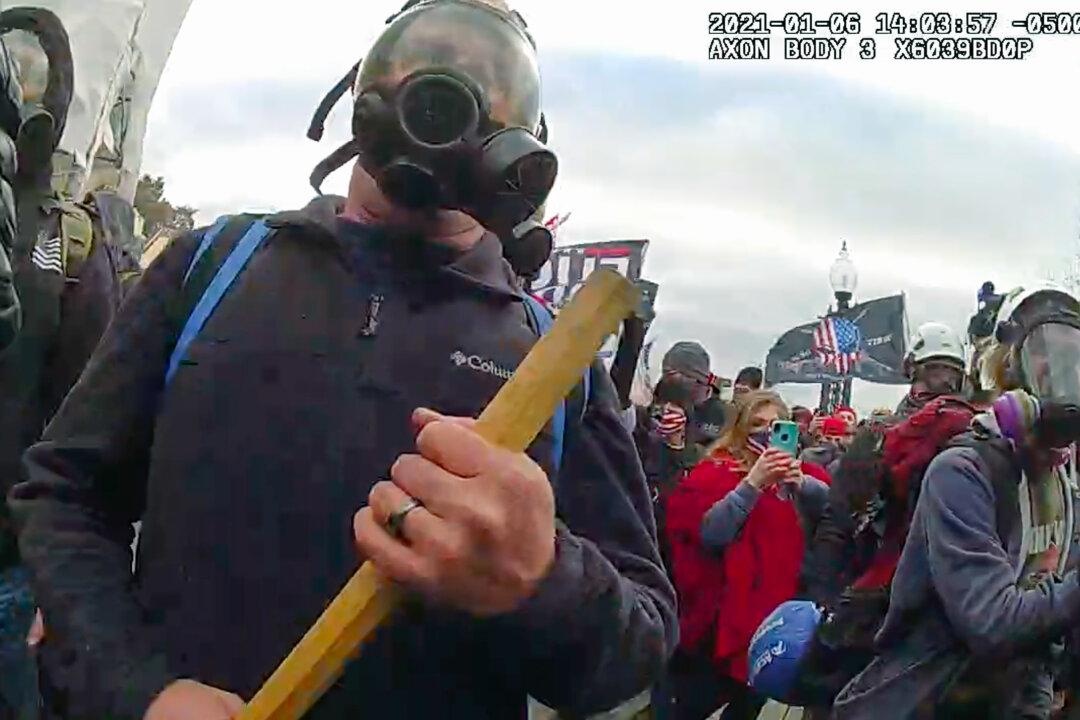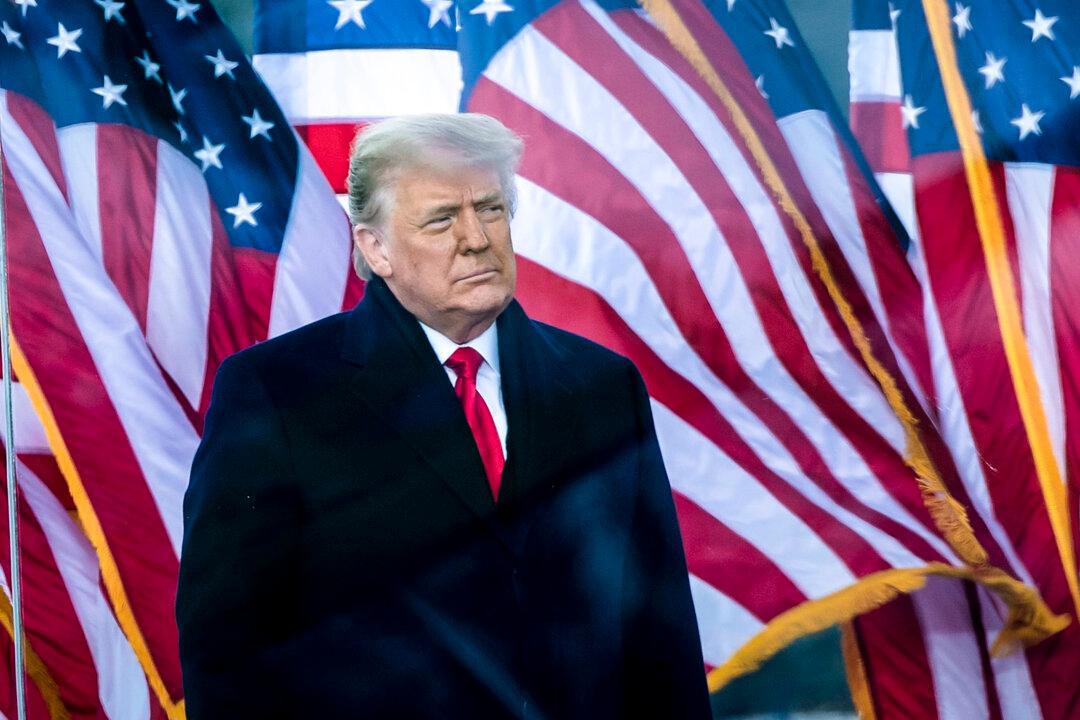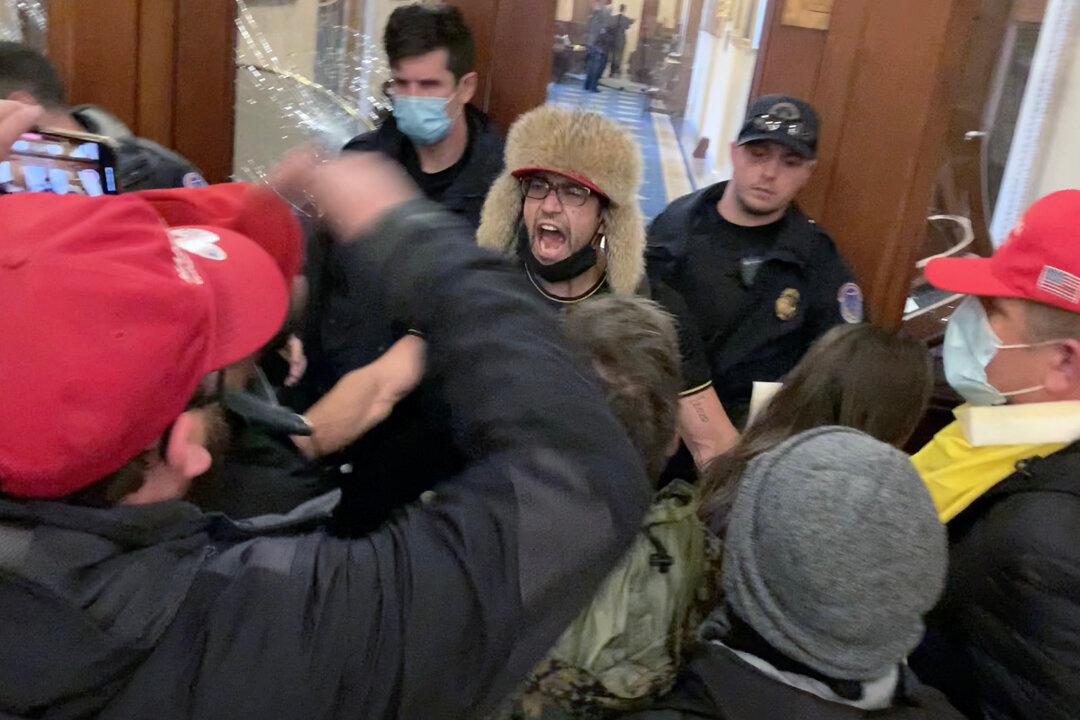It might have been the death threats.
Perhaps it was the fake sympathy cards sent to his office containing photos of his wife lying in a pool of her own blood.
Maybe it was the news media that called his wife a terrorist and an insurrectionist who “stormed the Capitol” and was shot dead in the process.
Aaron Babbitt has seen many depths in the nearly one year since his wife, Ashli, 35, was shot outside the Speaker’s Lobby at the U.S. Capitol. Grieving had to take a back seat. There was just too much to do.
Babbitt is a man on a mission. He aims to unearth the full truth of what took place on Jan. 6, 2021, and defend his wife’s memory in the process.
“I have an outlook on where I’m going to get this for Ashli,” Babbitt told The Epoch Times. “She will be celebrated. She will be remembered, and she will be revered. It’s going to happen.”
It’s been a long and difficult journey from the fateful day when he saw the shooting that took Ashli’s life played repeatedly on national television. So many days of heartbreak, but a few good days, too.
A July phone call from former President Donald Trump buoyed his spirits. How much he wished Ashli were there to take that call from the man who drew her to the nation’s capital on Jan. 6.
Life Is Changed Forever
None of that was on Aaron Babbitt’s mind when he finished his shift on Jan. 6 at the pool-cleaning company he ran with Ashli in San Diego. She’d taken a flight to Washington the day before to attend a rally in support of Trump.He had an appointment at the gym, then returned home. A phone call from a friend just before noon Pacific time was the first sign of trouble.
“I could just tell there was something off with his voice,” Babbitt said. “I don’t normally talk with this person a lot. He just said that his wife had told him she thought she had seen Ashli on TV. It looked like she had been hurt.”

Babbitt left the phone and tuned the television to Fox News. He wasn’t prepared for what he saw.
“The very first image that I saw was Ashli lying on the ground with blood coming out of her nose and mouth,” he said. “I recognized her immediately, based off her clothes, her hair, side profile, the boots she was wearing. I knew it was her. It was a very helpless feeling.”
“There’s no way to really process that,” he said. “I just went into a panic. It’s an emotion that I can’t explain, really, what was going through my head.”
Babbitt’s mind raced, searching for a possible explanation. Had she been attacked, or shot with a rubber bullet sometimes used by riot police? “The last thought in my mind was that an actual live round was fired inside the United States Capitol,” he said.
Before that first shock had fully registered, Babbitt heard words that in an instant changed his life—and his future—forever.
“I stepped out of the living room and I heard, I think it was Bill Hemmer. I’ll never forget the voice,” he said. “He came over the TV and said the woman who had been shot in the Capitol had passed away. That’s how I found out.”
The next thing Babbitt remembers is being in his kitchen, his house full of people. He had blacked out. He had no memory of anyone coming to the door. He grabbed his phone and began calling D.C. hospitals. No one seemed to know anything about a gunshot victim from the Capitol.
“I just started getting so confused and emotional,” he said. “I’m just yelling at them: ‘You have a gunshot victim. There’s only one person who was shot at the Capitol. Somebody knows, even if it’s a Jane Doe, it’s a white lady with a gunshot wound. Somebody has to tell me something.' I got hung up on a lot.”
Babbitt’s brother, a firefighter paramedic in Massachusetts, started calling fire houses in hopes of learning something. He called the Metropolitan Police Department of the District of Columbia. “They yelled at him, ‘We didn’t [expletive] shoot her! Stop calling!’” Babbitt said.
“When they yelled at my brother, that was just another dagger,” he said. “He was trying to help. He was just trying to work every angle.”
Confusion and Violence
Ashli was among the crowd who heard Trump speak at the “Save America” rally at the Ellipse in Washington. She later made her way over to the U.S. Capitol and eventually did what hundreds, if not thousands, did: entered the building and wandered around.She ended up in a hallway leading to the Speaker’s Lobby of the House of Representatives. Black Lives Matter activist John Sullivan, dressed as a Trump supporter, was doing his best to whip up the crowd and incite them, according to videos posted on social media. “Go! Go! Get this [expletive]!”

The glass windows in the double doors leading to the lobby were cracked. Someone smashed out the window just to the right of the doors. Sullivan, after suggesting two police officers stationed at the door should leave, shouted at the rioters to keep going.
At that moment, Ashli started climbing through the side window. Her head and shoulders had just emerged when the crack of gunfire was heard from a Glock 22 pistol fired by Capitol Police Lt. Michael Byrd.
Ashli fell backward onto the hallway floor, mortally wounded. The horror-filled scene captured by Sullivan’s video camera was sold to several networks for $90,000 (later seized by U.S. authorities). Witnesses said Sullivan bragged that it would be worth “millions.” Babbitt said the money paid to Sullivan makes the video “what I consider my wife’s snuff film.”
After carefully examining the video with his legal team, Babbitt said a very different explanation emerged from the narrative that Ashli was an insurrectionist determined to storm the House of Representatives.
“When those three guys move out away from that door, when those three cops move, right when they [vandals] start beating on the doors and the one guy is kicking the bottom of the door and they’re beating on the windows, Ashli is yelling at them to stop,” Babbitt said. “It’s a female voice in the background and you can hear her: ‘Wait! Stop! No! Don’t!’ She’s screaming at them. I can hear the panic in her voice.”
Babbitt said Ashli’s mother and her ex-husband listened to the video and identified the female voice as Ashli.
“Immediately when we all hear it, we’re like, ‘That’s definitely Ashli. That’s definitely 100 percent Ashli yelling at them to stop beating on those doors,” Babbitt said. “That was the moment she was like, ‘Where am I and what the hell am I doing?’ Unfortunately, we’re never going to get her side of it.”
Babbitt said he believes Ashli surveyed the quickly deteriorating situation and determined she had to escape. “She does not like crowds, and her only way of egress out of that area was through that window,” he said. “That’s my belief. That’s my personal belief.”
The Fatal Shot
Most of the blame for the fatal shooting rests with Byrd, Babbitt said.Video shows Byrd approach the barricaded doors with his service weapon drawn. His finger goes on and off the trigger. As Ashli’s head emerges from the window, he moves forward and fires the .40-caliber shot that struck Ashli in the left shoulder.
“There was no imminent threat,” Babbitt said. “The only person who thought my wife was an imminent threat was apparently him.”

Several police officers seen on video in the hall outside the Speaker’s Lobby could have easily detained Ashli if they felt she was a threat, Babbitt said.
“You see all of the cops, there’s three of them, they move out the way. They were standing right next to Ashli when she was murdered,” he said. “Anybody could have gotten their hands on her. She’s 5 foot 2 inches, 110 to 115 pounds, she could be controlled. Plus she had a backpack on. One of those guys behind her could have grabbed that backpack, pulled her down and put her in cuffs if they wanted.”
Babbitt said video gathered by his legal team shows minutes before he shot Ashli, Byrd could be seen “flagging everybody with that weapon.”
“Anybody that ever carries a firearm knows you don’t point at anything that you don’t intend to destroy,” Babbitt said. “He wants to say he saved a bunch of people’s lives. The only lives he saved were the ones he didn’t accidentally shoot by walking around that House chamber with his gun up and his finger on the trigger. It’s just a disgusting display of weapons handling.”
Babbitt said his lawyers filed a tort claim with the federal government for the shooting. They’re preparing a lawsuit.
The U.S. Department of Justice told Babbitt in a telephone call last spring that it wouldn’t pursue charges against Byrd for the shooting.
“It wasn’t even a shock to me at that point. It does seem like a strange decision, but it’s the swamp,” he said.
Former Co-Workers Become Spouses
Babbitt said he met Ashli at a nuclear power plant near Washington, D.C., where they both worked as security officers. On her first night on the job, Ashli approached Babbitt.“I turned around and Ashli was just standing there in my face,” he said. “‘You look like you’re pretty grumpy, bud. I’m going to make you talk to me.’ And she did. We talked for about 30 to 40 minutes.”

The Babbitts had military experience in common: him in the U.S. Marines and her as an Air Force and National Guard veteran who enlisted at age 17. They married on June 25, 2019. Babbitt said there are so many things he will always treasure about Ashli, none more than her spirit.
“Ashli, she was such a small package, but larger than life,” he said. “She just took over every room that she went into. She loved talking to people. We live in a tourist town. She just loved being out and about and talking to people from across the country.”
Ashli had a strong grip and liked to give a firm handshake, Babbitt said. It made a good impression. She loved the movies, with the 1998 film “The Big Lebowski” atop her favorites list. She had a passion for dogs, often bringing home strays. Her dog became depressed when she didn’t return from the Washington trip. In early February 2021, Babbitt came home to find him dead.
‘I’m Just Focused’
Babbitt said he made a very conscious decision not to let his grief cripple him, choosing instead to get engaged in a drive to find the truth.“I’m just focused. I don’t know where I’m at mentally,” he said. “I have my moments in private, a lot of tears. If this had happened to me, Ashli would probably be sleeping in a tent on the Capitol steps and demanding answers. So I have to fight for her.
“I had to come to terms that this is a fight that can’t be fought with fists. It has to be fought with folded hands,” he said.
“I maintain my cool and channel my energy, just trying to get justice for my wife, because she deserves it. Her voice is a very hard one to carry and speak for, but I’m doing what I can.”
Babbitt takes comfort knowing how much the trip to Washington to see Trump meant to his wife. She was deeply patriotic. Having worked in military law enforcement, she was a big supporter of the police. She was in her element at the Trump rally, celebrating freedom with other patriots.
“It was the best day of her life,” Babbitt said. “I tell people Ashli died on the best day of her life.”





